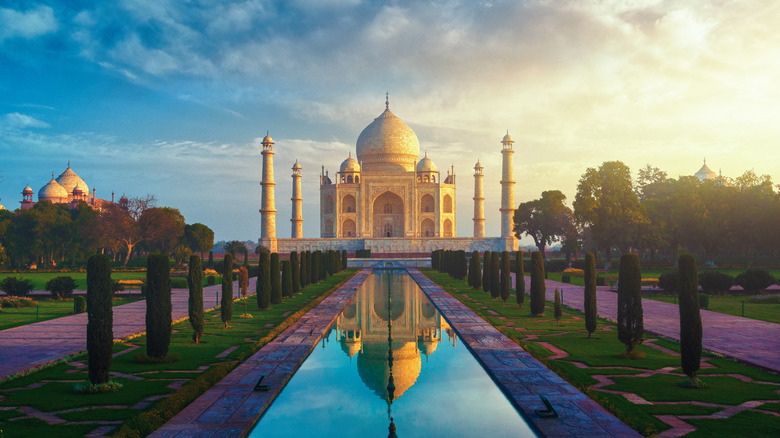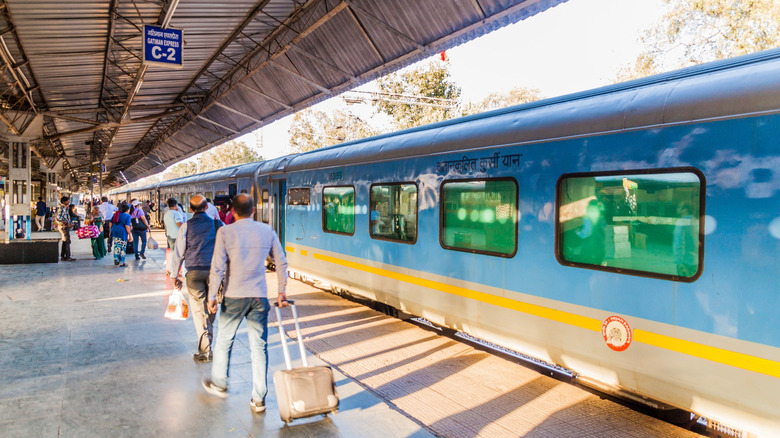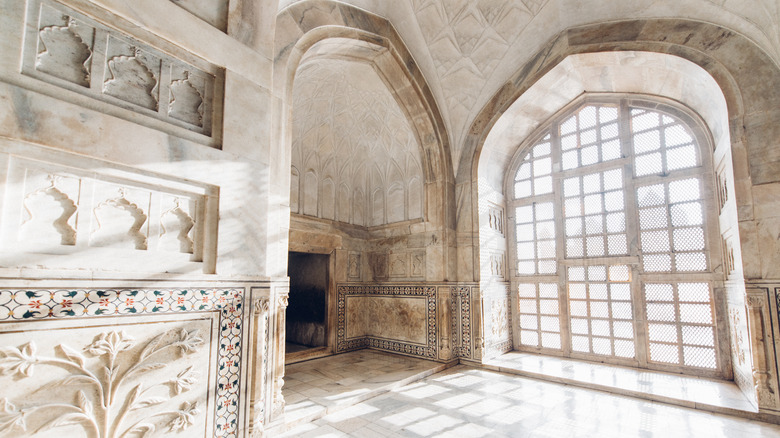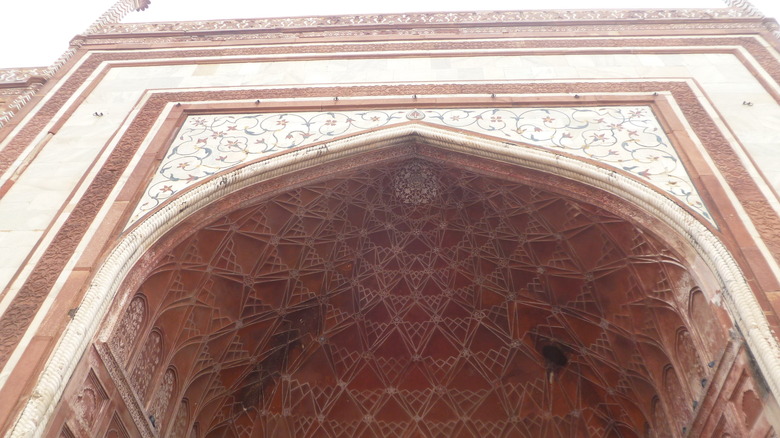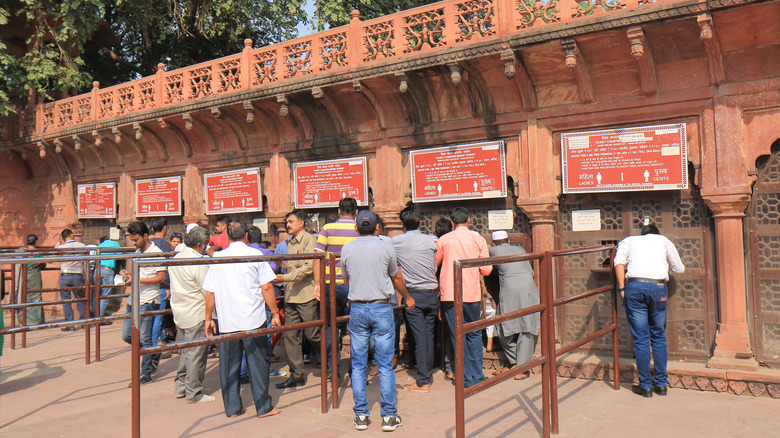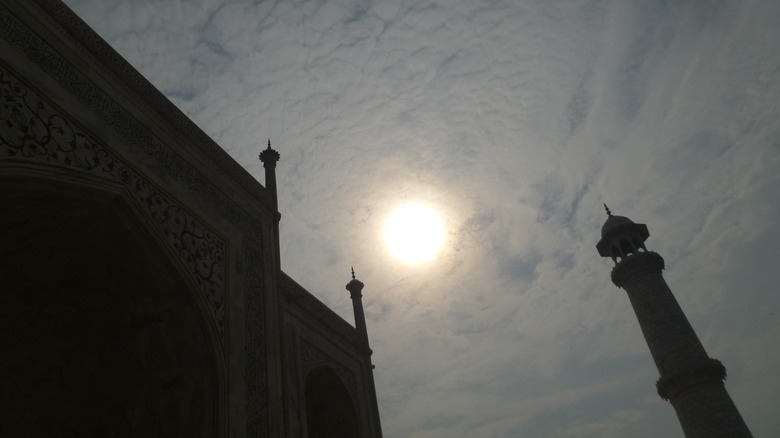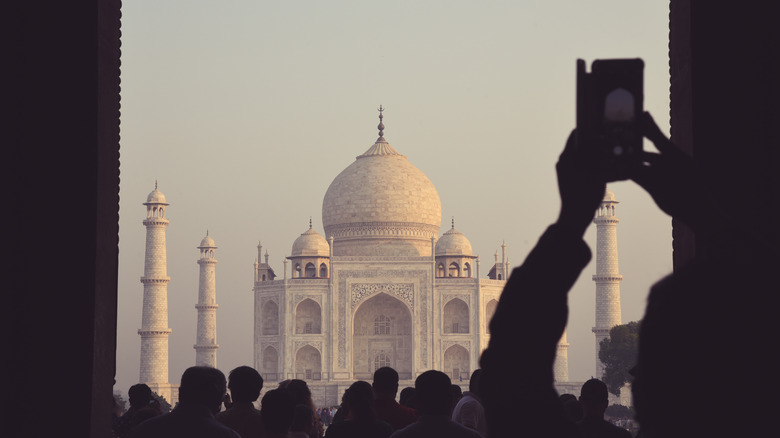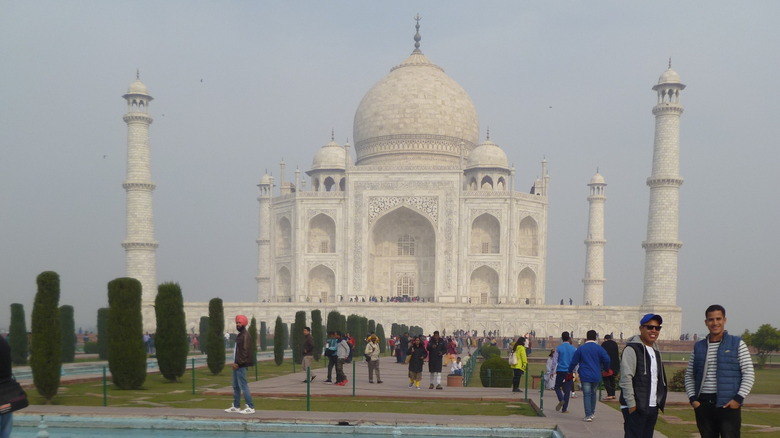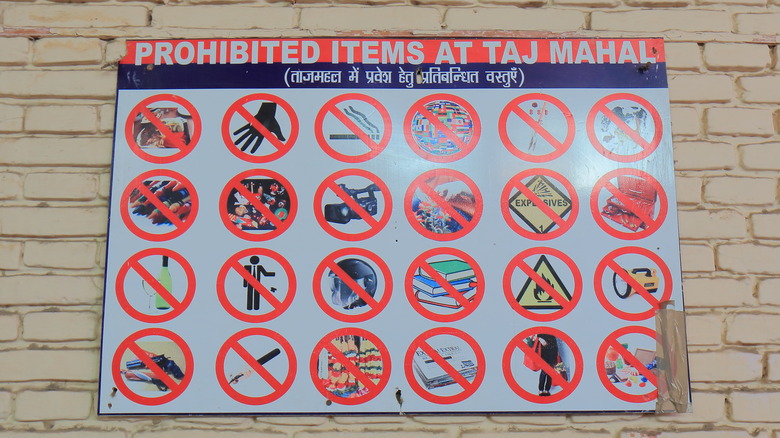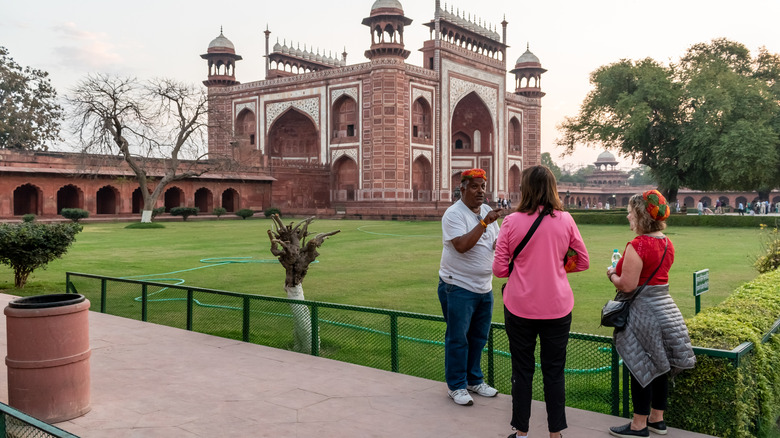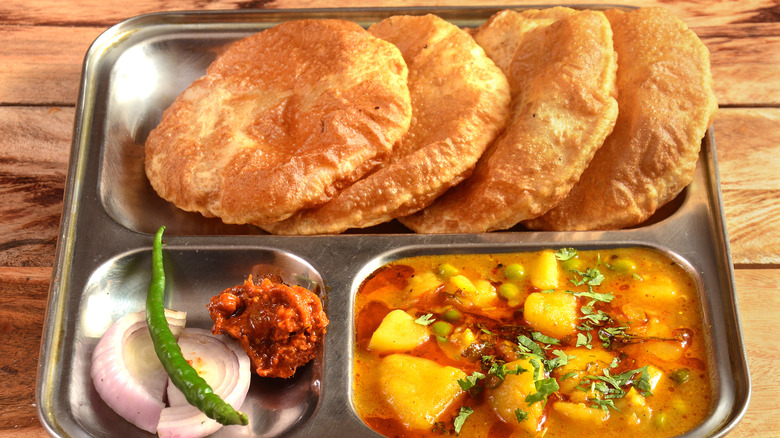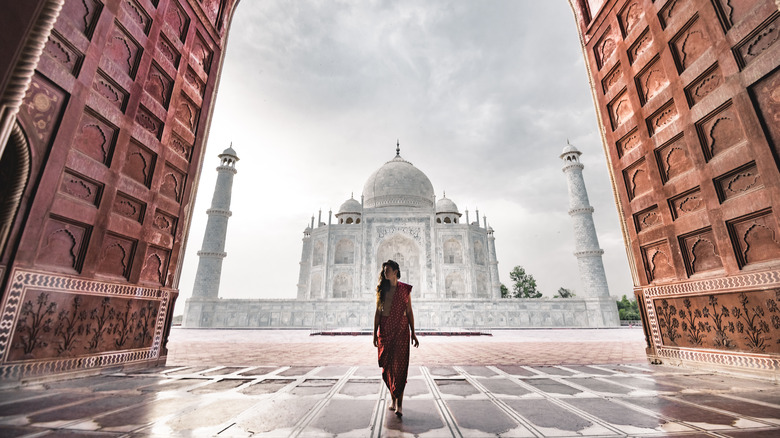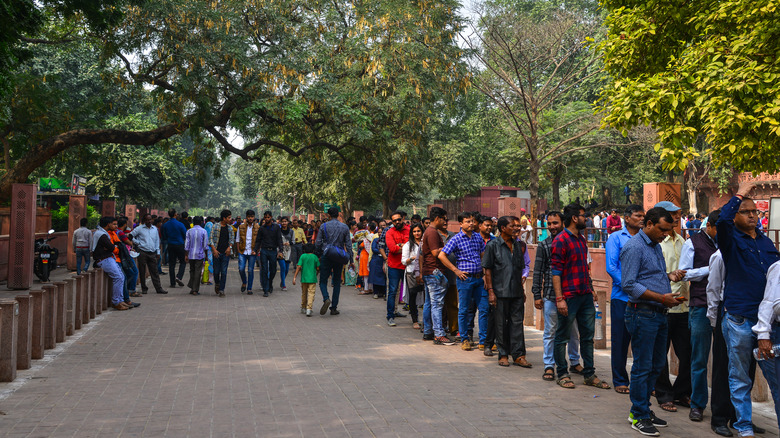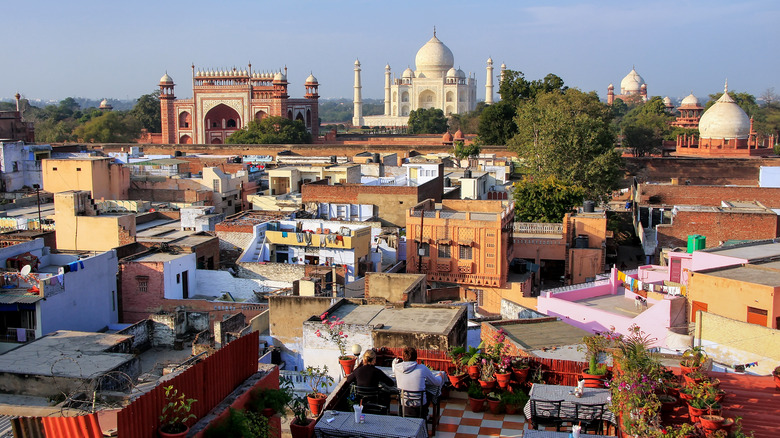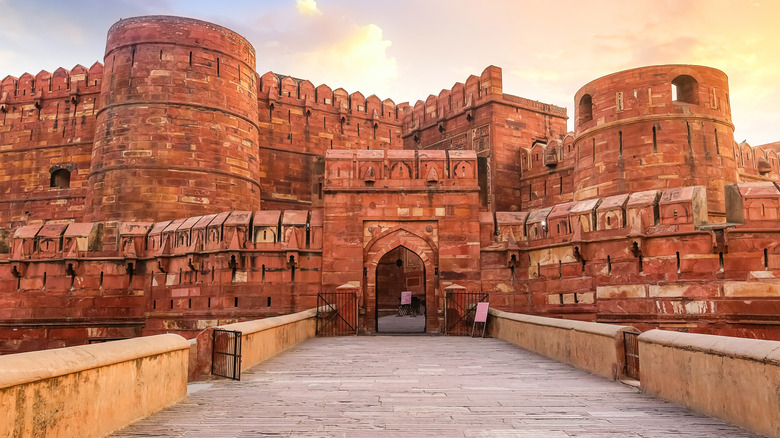Important Details You Should Know Before Visiting The Taj Mahal
In the ultimate ode to lost love, an emperor built the Taj Mahal for his wife, who perished after childbirth. One of the most famous buildings in the world, about 8 million people visit the Unesco World Heritage site each year, with about 10% arriving from outside India (via the official Taj Mahal website). For visitors to the country, the Taj Mahal is often one of the places that can't be missed.
This gleaming marble vision often appears as a stop within a well-worn tourist circuit across northern India as one part of the triangle that takes in New Delhi, Agra (where the Taj Mahal is located), and Jaipur. But visiting the Taj Mahal takes some planning and requires a little preparation, from the timing of a trip to the measures that you will need to take before stepping into the complex. This truly is one of the most special places on the planet, and with some forethought, you can ensure that the experience of seeing it for the first time won't disappoint.
It's blissfully easy to get to
Agra sits in the northern state of Uttar Pradesh, the most populated state in India, with more than 230 million people calling it home — about two-thirds of the population of the United States. The Taj Mahal is the prime tourist attraction in the whole of U.P. (as Indians tend to call it), a state that also includes the revered city of Varanasi, located on the banks of the River Ganges. Given the positioning of U.P. (it borders the Indian capital of New Delhi) and the popularity of Agra, the city has developed good travel connectivity. Agra has its own airport, a few miles from the Taj Mahal, with direct connections to a number of domestic destinations on carriers like IndiGo.
One of the more popular methods of getting to Agra is by train, and New Delhi is the largest major city in the environs; trains between the capital and Agra Cantonment station take between two to four hours, depending on the specific departure and can cost as little as $2 By road, buses frequently run with a starting price of about $4, and visitors can book a private transfer, with the three-hour journey costing around $30. Once in the city, ubiquitous taxis and autos (the Indian name for a tuk-tuk) will speedily get you to the Taj Mahal.
It's not a temple or palace
Due to the Taj Mahal's celebrity and the exquisiteness of its fine, delicate, brilliant form, many think the globally renowned structure functions as a deeply revered temple or the former palace of an outrageously wealthy ruler. But neither theory represents the truth, with the origins of the Taj Mahal grounded in a much more somber tale. While the Taj Mahal consists of a large complex, the main structure, a white cynosure with an onion-shaped dome, is, in fact, a mausoleum or resting place.
In the 1630s, Shah Jahan, a Mughal dynasty ruler, lost his wife, Mumtaz Mahal, when she gave birth to either their 13th or 14th child. Devastated by grief, Shah Jahan set about building a memorial to honor her. After completing it, he had her body buried in the main structure. Even though it does not serve as a place of worship, the Taj Mahal closes to visitors every Friday, except for Muslims who come to the mosque in the complex to offer their prayers.
Its construction is mightily impressive
When you look at the grandeur and incredible craft behind the Taj Mahal and realize the builders accomplished this almost four hundred years ago, it's hard not to be bowled over by this feat of ambition and dedication. The statistics behind the structure are undoubtedly eye-opening. It's believed to have taken Shah Jahan six months to simply finalize a site for the building, and the Taj Mahal's design folds in Hindu, Mughal, and Persian influences, with the use of white marble a stark departure from the traditional Mughal monuments made from red sandstone.
The creators inlaid the marble with precious and semi-precious stones (including Chinese jade, turquoise from Tibet, and sapphires from the Middle East), giving the building its majestic glimmer. Shah Jahan imported the materials to Agra from various parts of India, using 1,000 elephants to carry vast loads, and he put 20,000 laborers and artisans to the task of realizing his dream. The minarets at the four corners soar 130 feet into the air, while the central inner dome rises 81 feet. To appreciate the significance of the Taj Mahal, not just as a piece of architectural prowess or for its geometric precision but also its context in the history of India overall, visitors should take some time to learn about its background beforehand. They'll find plenty of literature about it, both in printed works and online.
Tickets are cheaper for Indians
Unlike tickets for show-stopping attractions in the United States, entry rates to the Taj Mahal vary depending on who you are or where you are coming from. For Indians and Overseas Citizens of India — people of Indian origin who don't live in India but can claim a link to the country through ancestry — entry costs 50 Indian Rupees (less than $1). For foreigners who are part of a South Asia regional agreement or from nations within an Asian alliance known as BIMSTEC, that price goes up to 540 Rupees (around $6.50).
The tickets cost even more for all other foreigners, at 1,110 Indian Rupees (about $13). While that's 22 times more than the price for an Indian, it's still a steal considering what you'll get to see. (For comparison, a self-guided audio tour of New York's St. Patrick's Cathedral, which is not regarded as a global icon, costs $20.) For any entry, whatever the price, visiting the mausoleum will set you back an additional 200 Rupees (around $2.41). You can purchase tickets online (though the online system did not work at the time of this writing) or at the entry gates for the complex. Children under 15, wherever they are from, can enter for free but will need to bring identification to prove their age.
The time of year matters
As with anywhere in the world, the high season tends to be the best time to visit the Taj Mahal for obvious reasons. The weather in Agra, on the whole, slots into very distinctive patterns, with November through February, the driest months, corresponding to the high season for seeing the site. March to May are the hottest months, while visitors can expect rain during the monsoon time of June to September. If you want to visit the Taj Mahal with the fewest crowds, aim to go to Agra during the wetter period and hope you pick a day when the clouds magically part; otherwise, you will not likely get any good photos.
For a month that sometimes has a great climate and fewer throngs, October can be a smart choice. Avoid visiting on Valentine's Day, as it's the one day in the year when lovestruck couples are guaranteed to descend on the Taj Mahal to profess their devotion at one of the greatest tributes to love on the planet. If you enjoy festivities, plan to come during Taj Mahotsav, a two-week celebration of arts, crafts, and performances each February near the Eastern Gate of the complex.
Visit more than once
In the past, entry to the Taj Mahal had a three-hour time limit, forcing visitors to enter and exit within 180 minutes. Nowadays, the organizers have separated ticket entry into less stringent windows — morning and afternoon — and visitors can spend as long as they want at the complex during those periods. The fluctuations of the sun govern the times when the Taj Mahal opens and closes: people can enter 30 minutes before sunrise, and the place closes 30 minutes before sunset. So, on longer days, it stays open for the greatest amount of time. While your plans might shape when exactly you can visit, we recommend, based on personal experience of seeing the Taj Mahal several times, that you go at least twice.
Beholding it in different lights amplifies the beauty of this icon, from the crisp rays of sunrise to the warming glow of sunset. Avoid the middle of the day, which brings hard and unforgiving light. For a special treat, try to book a viewing around a full moon — two days before the full moon, the day of it, and two days after, groups of 50 people at a time can enter the Taj Mahal for 30 minutes. The experience feels lifted from the pages of a fantasy tale.
You should wear the right clothing
While the Taj Mahal is not a religious site per se, it is a mausoleum that may instill joy and wonder in visitors but has a story steeped in sadness. As such, while it's not official policy, visitors should dress in the same way they might when visiting, say, a cemetery. This means no super-short and slash or super-tight shorts, no tank tops, no high skirts, and no sleeveless dresses — basically nothing revealing. If in doubt, go for more reserved and covered looks. After all, this is a place of reflection and solemnity, not a beach or nightclub.
When you visit the Taj Mahal, you may notice that the Indians there, whatever the weather, even if it's 90F out, will likely wear clothes that cover all of their legs, shoulders, and upper arms. Use that as a guide for a respectful look. You should also remember that the complex spans more than 40 acres. Wear comfortable shoes since you'll want to make the most of your visit and explore it all. Ditch the flip-flops in favor of padding and arch support.
The rules are there to be followed
Given its status as one of the most culturally rich sites in the country, the Indian government has adopted preventative measures to keep the Taj Mahal safe, in good condition, and available for visitors to enjoy for many more years. Entry is strictly controlled in terms of timing as a simple and practical way to manage the crowds. Foreigners get a free bottle of water and fabric covers for their shoes (like the ones surgeons might wear in an operating room) as part of their entry fee in an effort to keep the marble pristine. However, there is much that cannot be brought into the site.
While drones will let visitors get spectacular shots of the Taj Mahal, they are not allowed within the complex or anywhere around it. All food and drink — apart from the free water bottle — are banned, as are cigarettes and vapes, headphones, phone chargers, and even tripods. You must keep your phone on silent mode, and if you choose to pay extra to visit the mausoleum, know that you will not be allowed to take photos inside. If you get a night-viewing ticket, mobile phones will not be permitted, though regular, old-school cameras will. Travelers are also encouraged not to touch any walls or any part of the buildings; this helps preserve their integrity and ensures generations to come can enjoy the Taj Mahal in the same way you have.
Get a guide in advance
One thing that won't be in short supply is people around the Taj Mahal willing to show you around and be your guide, each undercutting the other to get your business. In reality, you don't need a guide, as so much information on the complex's history and why it was built is available in books and online. But sometimes, getting a guide adds extra layers of enjoyment to the experience; it helps bring the history and achievements of the place to life, and it also helps put money in a local family's pocket.
If you decide to get a guide, book one approved by the government (they will usually have a tag or identification hanging around their neck), or ask for tips from the hotel where you are staying. It would be best if you didn't choose someone hanging around the entrance who manages to catch your eye and won't stop hassling you. Inside the complex, guards might try to tell you stories about the Taj Mahal, acting as a sort of guide, and then ask you for a tip after the tale — resist giving them one since you didn't solicit the information, so you shouldn't be expected to pay for it. Unlike the United States, India does not have a tipping culture, and not tipping them will not be considered untoward.
Eat a solid meal before you enter
While the Taj Mahal, with its sensual curves and soaring, sleek minarets, is the main attraction of this destination, it's not the sole thing to see. There are gardens, the mosque, and more, which means you will be there for a while. Since you aren't allowed to bring any food or drink (not even sugary candies that might help give you a little boost of energy if your spirits start to flag), eating a big meal before you enter is essential.
Fueling up will allow you to walk around the complex without feeling tired or weak. Thankfully, there are plenty of places near the Taj Mahal where visitors can sample local delicacies. Among the regional treats are bedai aloo, a puffed-up flatbread served with a spiced potato side dish and fresh yogurt, and classic Mughal dishes like kebabs, naans, and savory cooked meats. Deviram Sweets serves highly lauded bedai aloo and has a few branches in Agra, including one not far from the Taj Mahal.
Don't rush your visit
Unless you have unlimited time and funds at your disposal, your visit to the Taj Mahal might be the only time you get to see the building. You should definitely make a trip to the site, which was designated in July 2007 as a New7Wonders of the World. It's important to take time with your visit and pore over the area. You should plan to visit it twice, but if you only have time for one stop, come in the morning. Get there as soon as tickets are sold. Also, get plenty of rest the night beforehand; there is no point in dragging yourself around the Taj Mahal all haggard (imagine the photos!).
Once inside, look over the Taj Mahal, of course, but also wander around the gardens, the gateway, the courtyards, and the cloisters. Don't just give details cursory glances; look at inscriptions around the site and survey the main domed structure from many different angles. That way, you will see how the shapes and light transform and complement one another, and each vista will give you a newfound appreciation for this marvel.
People might stare at you
If you don't look Indian, locals might stare at you with a fixed, unrelenting gaze, one freighted with deep concentration and singular focus. However, this unwavering locking of eyes is likely not meant to intimidate or make you uncomfortable, even if it does. It's just that many Indians are intrigued by foreigners or people that they perceive as foreigners, which is not surprising when one considers that less than one-half of a percent of people living in India are from other countries (in the United States, that number is more than 10%).
Of that small percentage, many hail from other nations in South Asia, and so won't look vastly different. So, when someone is an outlier and wavers from the norm — imagine seeing an iceberg in Florida or a papaya tree in the Yukon — it might pique interest and curiosity and prompt a bystander to ask if they can take their photo with you. While your response will come down to the circumstances and personal preference, moving elsewhere or to a different part of the complex will often be the easiest way to exit an uncomfortable situation. Similarly, if you'd prefer not to have your photo taken, try saying "no thank you" and walking away.
Stay near the Taj Mahal
Agra is by no means the largest city in the country, but it's still big, and its population is estimated to be more than 2 million people. Given these numbers and the undeniably powerful lure of the Taj Mahal to tourists, both Indian and from overseas, the city has developed a strong hospitality sector, and there are tons of places to stay very close to the Taj Mahal in an area known as the Taj Ganj.
If money is no object, Oberoi Amarvilas would be the ultimate retreat, with beautiful Mughal-inspired sandstone exteriors and views of the Taj Mahal, which is less than half a mile away from various vantage points. For those looking to spend a little less, there are many cheap places to stay near the complex. We'd recommend finding a small local property or a rental apartment in the vicinity — there is something exciting about getting up early, maybe when mist still blankets the city on a winter morning, and walking to the Taj Mahal. The act and anticipation of that journey add to the thrill of the experience.
Go to other Agra sites
The Taj Mahal might be the most magnetic site in the city, but it's not the only place worth a visit. That said, it should be top of your list. If time is not on your side and you only have the opportunity to spend a few hours in Agra, make sure they are at the Taj Mahal. If your schedule permits, however, carve out a trip to see Mehtab Bagh across the Yamuna River. With a name that translates to "the Moonlight Garden," this slash of greenery is pretty in itself, but the views of the Taj Mahal are phenomenal, and it's much less busy than the more famous site that it looks onto.
Not far from the Taj Mahal, Agra Fort, also a Unesco World Heritage site, has imposing red sandstone structures and a solid wall that wraps around it, with beautiful buildings within. Shah Jahan also built it. Moti Masjid, or Pearl Mosque, is particularly noteworthy within the fort. It is a place of prayer constructed of white marble and featuring intricate carvings.
